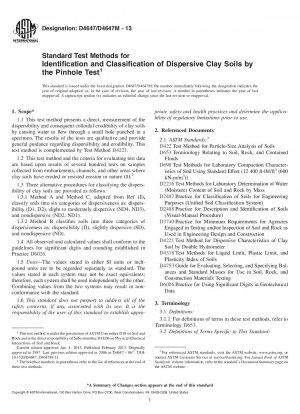ASTM D4647/D4647M-13
Standard Test Methods for Identification and Classification of Dispersive Clay Soils by the Pinhole Test
- Standard No.
- ASTM D4647/D4647M-13
- Release Date
- 2013
- Published By
- American Society for Testing and Materials (ASTM)
- Status
- Replace By
- ASTM D4647/D4647M-13(2020)
- Latest
- ASTM D4647/D4647M-13(2020)
- Scope
5.1 The pinhole test provides one method of identifying the dispersive characteristics of clay soils that are to be or have been used in earth construction. The piping failures of a number of homogeneous earth dams, erosion along channel or canal banks, and rainfall erosion of earthen structures have been attributed to the colloidal erosion along cracks or other flow channels formed in masses of dispersive clay (2).
5.2 This test method models the action of water flowing along a crack in an earth embankment. Other indirect tests, such as the double hydrometer test (Test Method D4221), the crumb test (3, 4), that relates the turbidity of a cloud of suspended clay colloids as an indicator of the clay dispersivity, and chemical tests that relate the percentage of sodium to total soluble salt content of the soil are also used as indicator tests of clay dispersibility (2). The comparison of results from the pinhole test and other indirect tests on hundreds of samples indicates that the results of the pinhole test have the best correlation with the erosional performance of clay soils in nature.
5.3 Method A and Method C of the pinhole test require the evaluation of cloudiness of effluent, final size of the pinhole, and computation of flow rates through the pinhole in order to classify the dispersive characteristics of the soil. Method B requires only the evaluation of the cloudiness of effluent and final size of the pinhole to classify the dispersive characteristics of the soil. The computation of flow rates through the pinhole in Method A serves primarily as a guide to the proper equipment and specimen performance under sequential pressures applied during the test. All methods produce similar results and any method can be used to identify dispersive clays.
5.4 The use of Method A or Method C results in the accumulation of data relative to sequential flow rates through the pinhole and consequent enlargement or erosion of the hole. The pinhole erosion test was developed for the purpose of identifying dispersive soils and is not intended to be a geometrically scaled model of a prototype structure. Since the theory of similitude was not used in the design of the pinhole test, quantitative data are not obtained. The quantity of flow through the pinhole, amount of soil erosion, or the rate of soil erosion should not be extrapolated to actual field conditions (3). However, such data may be useful in performing qualitative evaluations of the consequences of such erosion in terms of dam failure, loss of life and property. They also may be used in considering the cost effectiveness of defensive design measures necessary to minimize the effects of failure due to dispersive clays. For example, the amount of colloidal erosion that will occur in a soil classed as ND2 (very slightly dispersive) will be very small for a relatively long period of time. Such erosion may not be significant in evaluating the cost-benefit relationships in projects where public safety is not involved or where normal maintenance procedures will handle the ......
ASTM D4647/D4647M-13 Referenced Document
- ASTM D2216 Standard Test Method for Laboratory Determination of Water (Moisture) Content of Soil and Rock by Mass
- ASTM D2487 Standard Test Method for Classification Of Soils For Engineering Purposes
- ASTM D2488 Recommended Practice for Description Of Soils (Visual-Manual Procedure)
- ASTM D3740 Standard Practice for Minimum Requirements for Agencies Engaged in the Testing and/or Inspection of Soil and Rock as Used in Engineering Design and Construction
- ASTM D422 Standard Test Method for Particle-Size Analysis of Soils
- ASTM D4221 Standard Test Method for Dispersive Characteristics of Clay Soil by Double Hydrometer
- ASTM D4318 Standard Test Methods for Liquid Limit, Plastic Limit, and Plasticity Index of Soils
- ASTM D4753 Standard Specification for Evaluating, Selecting, and Specifying Balances and Scales for Use in Soil, Rock, and Construction Materials Testing
- ASTM D6026 Standard Practice for Using Significant Digits in Geotechnical Data
- ASTM D653 Standard Terminology Relating to Soil, Rock, and Contained Fluids
- ASTM D698 Standard Test Methods for Laboratory Compaction Characteristics of Soil Using Standard Effort (12 400 ft-lbf/ft3 (600 kN-m/m3))
ASTM D4647/D4647M-13 history
- 2020 ASTM D4647/D4647M-13(2020) Standard Test Methods for Identification and Classification of Dispersive Clay Soils by the Pinhole Test
- 2013 ASTM D4647/D4647M-13 Standard Test Methods for Identification and Classification of Dispersive Clay Soils by the Pinhole Test
- 2006 ASTM D4647-06e1 Standard Test Method for Identification and Classification of Dispersive Clay Soils by the Pinhole Test
- 2006 ASTM D4647-06 Standard Test Method for Identification and Classification of Dispersive Clay Soils by the Pinhole Test
- 2006 ASTM D4647-93(2006) Standard Test Method for Identification and Classification of Dispersive Clay Soils by the Pinhole Test
- 1993 ASTM D4647-93(1998)e1 Standard Test Method for Identification and Classification of Dispersive Clay Soils by the Pinhole Test

Copyright ©2024 All Rights Reserved